The Humus in the a Horizon Contains That Feed Plants
Soil Composition
Soil is a mix of varying amounts of inorganic matter, organic matter, water, and air.
Learning Objectives
Explain soil composition
Key Takeaways
Key Points
- The chemical composition of the soil, the topography, and the presence of living organisms determines the quality of soil.
- In general, soil contains 40-45% inorganic matter, 5% organic matter, 25% water, and 25% air.
- In order to sustain plant life, the proper mix of air, water, minerals, and organic material is required.
- Humus, the organic material in soil, is composed of microorganisms (dead and alive) and decaying plants.
- The inorganic material of soil is composed of rock, which is broken down into small particles of sand (0.1 to 2 mm), silt (0.002 to 0.1 mm), and clay (less than 0.002 mm).
- Loam is a soil that is a mix sand, silt, and humus.
Key Terms
- loam: soil with no dominant particle size that contains a mixture of sand, silt, and humus
- humus: a large group of natural organic compounds found in the soil composed of decaying plants and dead and living microorganisms
Soil Composition
Plants obtain inorganic elements from the soil, which serves as a natural medium for land plants. Soil is the outer, loose layer that covers the surface of Earth. Soil quality, a major determinant, along with climate, of plant distribution and growth, depends not only on the chemical composition of the soil, but also the topography (regional surface features) and the presence of living organisms.
Soil consists of these major components:
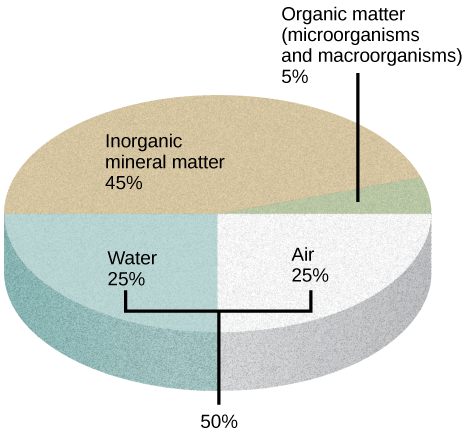
Components of soil: The four major components of soil are shown: inorganic minerals, organic matter, water, and air.
- inorganic mineral matter, about 40 to 45 percent of the soil volume
- organic matter, about 5 percent of the soil volume
- water, about 25 percent of the soil volume
- air, about 25 percent of the soil volume
The amount of each of the four major components of soil depends on the quantity of vegetation, soil compaction, and water present in the soil. A good, healthy soil has sufficient air, water, minerals, and organic material to promote and sustain plant life.
The organic material of soil, called humus, is made up of microorganisms (dead and alive), and dead animals and plants in varying stages of decay. Humus improves soil structure, providing plants with water and minerals. The inorganic material of soil is composed of rock, slowly broken down into smaller particles that vary in size. Soil particles that are 0.1 to 2 mm in diameter are sand. Soil particles between 0.002 and 0.1 mm are called silt, and even smaller particles, less than 0.002 mm in diameter, are called clay. Some soils have no dominant particle size, containing a mixture of sand, silt, and humus; these soils are called loams.
Physical Properties of Soil
Soils are made up of combinations of four distinct layer types or horizons: O horizon, A horizon, B horizon, and C horizon.
Learning Objectives
Describe the physical properties or profile of soil
Key Takeaways
Key Points
- The O horizon, or topsoil, is made of decaying organisms and plant life; it is responsible for plant production.
- The A horizon is of a mixture of organic material and inorganic products of weathering; it is the beginning of true mineral soil.
- The B horizon, or subsoil, is a dense layer of mostly fine material that has been pushed down from the topsoil.
- The C horizon, or soil base, is located just above bedrock and is made of parent, organic, and inorganic material.
Key Terms
- topsoil: top layer of soil containing humus at its surface and decomposing vegetation at its base; the most fertile soil
- subsoil: dense layer of soil containing fine material that has moved downward; the layer of earth that is below the topsoil
Physical Properties of the Soil
Soils are named and classified based on their horizons. The soil profile has four distinct layers:

Soil profile: This soil profile shows the different soil layers (O horizon, A horizon, B horizon, and C horizon) found in typical soils.
- The O horizon has freshly-decomposing organic matter, humus, at its surface, with decomposed vegetation at its base. Humus enriches the soil with nutrients, enhancing soil moisture retention. Topsoil, the top layer of soil, is usually two to three inches deep, but this depth can vary considerably. For instance, river deltas, such as the Mississippi River delta, have deep layers of topsoil. Topsoil is rich in organic material. Microbial processes occur there; it is responsible for plant production.
- The A horizon consists of a mixture of organic material with inorganic products of weathering; it is the beginning of true mineral soil. This horizon is typically darkly colored because of the presence of organic matter. In this area, rainwater percolates through the soil and carries materials from the surface.
- The B horizon, or subsoil, is an accumulation of mostly fine material that has moved downward, resulting in a dense layer in the soil. In some soils, the B horizon contains nodules or a layer of calcium carbonate.
- The C horizon, or soil base, includes the parent material, plus the organic and inorganic material that is broken down to form soil. The parent material may be either created in its natural place or transported from elsewhere to its present location. Beneath the C horizon lies bedrock.
Some soils may have additional layers, or lack one of these layers. The thickness of the layers is also variable, depending on the factors that influence soil formation. In general, immature soils may have O, A, and C horizons, whereas mature soils may display all of these, plus additional layers.
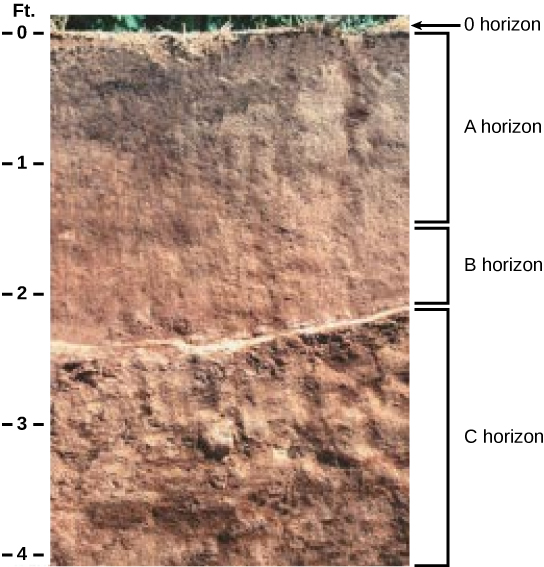
Mature soil: The San Joaquin soil is a mature soil that has an O horizon, A horizon, B horizon, and C horizon.
Mycorrhiza
A mycorrhiza is a symbiotic association between a fungus and the roots of a vascular plant.
Learning Objectives
Evaluate mycorrhiza as a plant symbiote
Key Takeaways
Key Points
- In a mycorrhizal association, the fungus colonizes the host plant's roots, either intracellularly as in arbuscular mycorrhizal fungi (AMF or AM) or extracellularly as in ectomycorrhizal fungi.
- Mycorrhiza are named after their presence in the plant's rhizosphere (root system). This mutualistic association provides the fungus with relatively constant and direct access to carbohydrates, such as glucose and sucrose.
- Plants grown in sterile soils and growth media often perform poorly without the addition of spores or hyphae of mycorrhizal fungi to colonize the plant roots and aid in the uptake of soil mineral nutrients.
Key Terms
- mycorrhiza: A symbiotic relationship between the mycelium of a fungus and the roots of a plant.
A mycorrhiza is a symbiotic (generally mutualistic, but occasionally weakly pathogenic) association between a fungus and the roots of a vascular plant.
In a mycorrhizal association, the fungus colonizes the host plant's roots, either intracellularly as in arbuscular mycorrhizal fungi (AMF or AM) or extracellularly as in ectomycorrhizal fungi. They are an important component of soil life and soil chemistry. Mycorrhizas form a mutualistic relationship with the roots of most plant species. While only a small proportion of all species has been examined, 95% of those plant families are predominantly mycorrhizal.
They are named after their presence in the plant's rhizosphere (root system). This mutualistic association provides the fungus with relatively constant and direct access to carbohydrates, such as glucose and sucrose. The carbohydrates are translocated from their source (usually leaves) to root tissue and on to the plant's fungal partners. In return, the plant gains the benefits of the mycelium's higher absorptive capacity for water and mineral nutrients due to the comparatively large surface area of mycelium: root ratio, thus improving the plant's mineral absorption capabilities. Plant roots alone may be incapable of taking up phosphate ions that are demineralized in soils with a basic pH. The mycelium of the mycorrhizal fungus can, however, access these phosphorus sources and make them available to the plants they colonize.
Suillus tomentosus, a fungus, produces specialized structures, known as tuberculate ectomycorrhizae, with its plant host lodgepole pine (Pinus contorta var. latifolia). These structures have in turn been shown to host nitrogen fixing bacteria which contribute a significant amount of nitrogen and allow the pines to colonize nutrient-poor sites.
Plants grown in sterile soils and growth media often perform poorly without the addition of spores or hyphae of mycorrhizal fungi to colonize the plant roots and aid in the uptake of soil mineral nutrients.
Fungi have been found to have a protective role for plants rooted in soils with high metal concentrations, such as acidic and contaminated soils. Pine trees inoculated with Pisolithus tinctorius planted in several contaminated sites displayed high tolerance to the prevailing contaminant, survivorship, and growth.
Mycorrhizas are present in 92% of plant families studied (80% of species), with arbuscular mycorrhizas being the ancestral and predominant form and the most prevalent symbiotic association found in the plant kingdom. The structure of arbuscular mycorrhizas has been highly conserved since their first appearance in the fossil record.
Wetland Soils
Wetlands are considered one of the most biologically diverse of all ecosystems.
Learning Objectives
Assess the composition of wetland soils
Key Takeaways
Key Points
- Nutrient cycling in lakes and freshwater wetlands depends heavily on redox conditions.
- Some anaerobic microbial processes include denitrification, sulfate reduction and methanogenesis and are responsible for the release of N2 (nitrogen), H2S (hydrogen sulfide) and CH4 (methane).
- Other anaerobic microbial processes are linked to changes in the oxidation state of iron and manganese and as a result of anaerobic decomposition, the soil stores large amounts of organic carbon because decomposition is incomplete.
Key Terms
- denitrification: The process by which a nitrate becomes molecular nitrogen, especially by the action of bacteria.
- methanogenesis: The generation of methane by anaerobic bacteria.
- heterotroph: An organism that requires an external supply of energy in the form of food as it cannot synthesize its own.
A wetland is a land area that is saturated with water, either permanently or seasonally, such that it takes on the characteristics of a distinct ecosystem. Primarily, the factor that distinguishes wetlands from other land forms or water bodies is the characteristic vegetation that is adapted to its unique soil conditions: Wetlands consist primarily of hydric soil, which supports aquatic plants. The water found in wetlands can be saltwater, freshwater, or brackish. Main wetland types include swamps, marshes, bogs and fens. Sub-types include mangrove, carr, pocosin, and varzea.
Wetlands play a number of roles in the environment, principally water purification, flood control, and shoreline stability. Wetlands are also considered the most biologically diverse of all ecosystems, serving as home to a wide range of plant and animal life.
In balanced soil, plants grow in an active and steady environment. The mineral content of the soil and its heartiful structure are important for their well-being, but it is the life in the earth that powers its cycles and provides its fertility. Without the activities of soil organisms, organic materials would accumulate and litter the soil surface, and there would be no food for plants.
The soil biota includes:
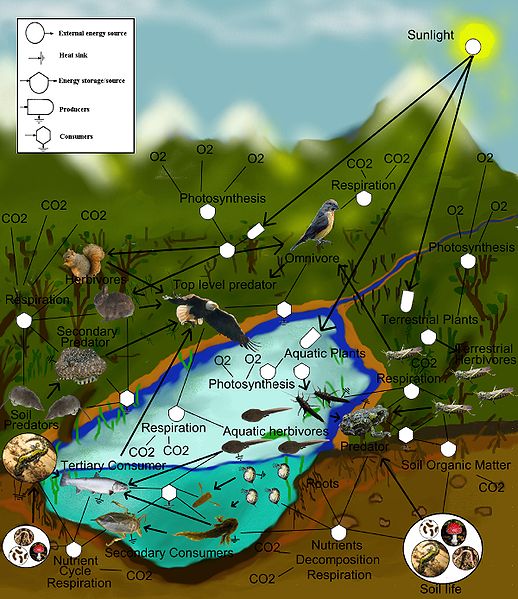
A freshwater aquatic and terrestrial food-web.: The food web is a complex and interconnected.
Megafauna: size range - 20 mm upward, e.g. moles, rabbits, and rodents.
Mesofauna: size range - 100 micrometres to 2 mm, e.g. tardigrades, mites, and springtails.
Microfauna and Microflora: size range - 1 to 100 micrometres, e.g. yeasts, bacteria (commonly actinobacteria), fungi, protozoa, roundworms, and rotifers.
Of these, bacteria and fungi play key roles in maintaining a healthy soil. They act as decomposers that break down organic materials to produce detritus and other breakdown products. Soil detritivores, like earthworms, ingest detritus and decompose it. Saprotrophs, well represented by fungi and bacteria, extract soluble nutrients from delitro. The ants (macrofaunas) help by breaking down in the same way but they also provide the motion part as they move in their armies. Also the rodents, wood-eaters help the soil to be more absorbent.
Nutrient cycling in lakes and freshwater wetlands depends heavily on redox conditions. Under a few millimeters of water heterotrophic bacteria metabolize and consume oxygen. They therefore deplete the soil of oxygen and create the need for anaerobic respiration. Some anaerobic microbial processes include denitrification, sulfate reduction and methanogenesis and are responsible for the release of N2 (nitrogen), H2S (hydrogen sulfide) and CH4 (methane). Other anaerobic microbial processes are linked to changes in the oxidation state of iron and manganese. As a result of anaerobic decomposition, the soil stores large amounts of organic carbon because decomposition is incomplete.
The redox potential describes which way chemical reactions will proceed in oxygen deficient soils and controls the nutrient cycling in flooded systems. Redox potential, or reduction potential, is used to express the likelihood of an environment to receive electrons and therefore become reduced. For example, if a system already has plenty of electrons (anoxic, organic-rich shale) it is reduced and will likely donate electrons to a part of the system that has a low concentration of electrons, or an oxidized environment, to equilibrate to the chemical gradient. The oxidized environment has high redox potential, whereas the reduced environment has a low redox potential.
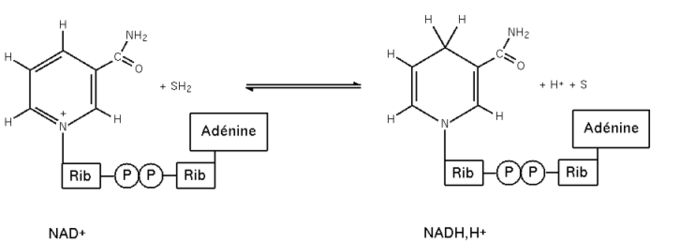
Redox Potential: The redox potential describes which way chemical reactions will proceed in oxygen deficient soils and controls the nutrient cycling in flooded systems.
The redox potential is controlled by the oxidation state of the chemical species, pH and the amount of oxygen (O2) there is in the system. The oxidizing environment accepts electrons because of the presence of O2, which acts as electron acceptors:
O2 + 4e- + 4H+ → H2O
This equation will tend to move to the right in acidic conditions which causes higher redox potentials to be found at lower pH levels. Bacteria, heterotrophic organisms, consume oxygen while decomposing organic material which depletes the soils of oxygen, thus increasing the redox potential. In low redox conditions the deposition of ferrous iron (Fe2+) will increase with decreasing decomposition rates, thus preserving organic remains and depositing humus.
Endophytes and Plants
An endophyte is an endosymbiont, often a bacterium or fungus, that lives within a plant for at least part of its life without causing apparent disease.
Learning Objectives
Evaluate endophytes as plant pathogens
Key Takeaways
Key Points
- Endophytes are ubiquitous and have been found in all the species of plants studied to date.
- Vertically transmitted fungal endophytes are asexual and transmit via fungal hyphae penetrating the host 's seeds (e.g., Neotyphodium).
- The wide range of compounds produced by endophytes have been shown to combat pathogens and even cancers in animals including humans.
Key Terms
- endophyte: Any organism that lives inside another plant.
An endophyte is an endosymbiont, often a bacterium or fungus, that lives within a plant for at least part of its life without causing apparent disease. Endophytes are ubiquitous and have been found in all the species of plants studied to date. However, most of these endophyte/plant relationships are not well understood. Many economically important forage and turfgrasses (e.g., Festuca spp., Lolium spp.) carry fungal endophytes (Neotyphodium spp.) which may improve the ability of these grasses to tolerate abiotic stresses such as drought, as well as improve their resistance to insect and mammalian herbivores.
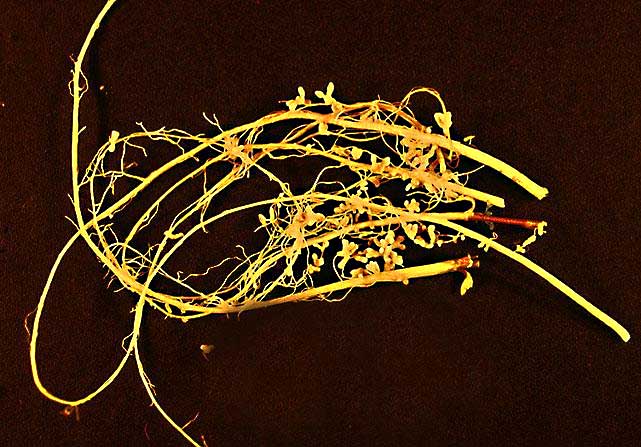
Root nodules on a legume: Soybean root nodules, each containing billions of Bradyrhizobium bacteria.
Endophytes may be transmitted either vertically (directly from parent to offspring) or horizontally (from individual to unrelated individual). Vertically transmitted fungal endophytes are asexual and transmit via fungal hyphae penetrating the host's seeds (e.g., Neotyphodium). Since their reproductive fitness is intimately tied to that of their host plant, these fungi are often mutualistic. Conversely, horizontally transmitted fungal endophytes are sexual and transmit via spores that can be spread by wind and/or insect vectors. Since they spread in a similar way to pathogens, horizontally transmitted endophytes are often closely related to pathogenic fungi, although they are not pathogenic themselves.
Endophytes may benefit host plants by preventing pathogenic organisms from colonizing them. Extensive colonization of the plant tissue by endophytes creates a "barrier effect," where the local endophytes outcompete and prevent pathogenic organisms from taking hold. Endophytes may also produce chemicals which inhibit the growth of competitors, including pathogenic organisms. Some bacterial endophytes have proven to increase plant growth. The presence of fungal endophytes can cause higher rates of water loss in leaves. However, certain fungal endophytes help plants survive drought and heat. Plant use of endophytic fungi in defense is a very common phenomenon, primarily involving the arbuscular mycorrhizal fungi.
The wide range of compounds produced by endophytes have been shown to combat pathogens and even cancers in animals including humans. One notable endophyte with medicinal benefits to humans was discovered by Gary Strobel: Pestalotiopsis microspora, an endophytic fungus of Taxus wallachiana (Himalayan Yew) was found to produce taxol. Endophytes are also being investigated for roles in agriculture and biofuels production. Inoculating crop plants with certain endophytes may provide increased disease or parasite resistance while others may possess metabolic processes that convert cellulose and other carbon sources into "myco-diesel" hydrocarbons and hydrocarbon derivatives. Piriformospora indica is an interesting endophytic fungus of the order Sebacinales, the fungus is capable of colonizing roots and forming symbiotic relationship with every possible plant on earth. P. indica has also been shown to increase both crop yield and plant defence of a variety of crops (barley, tomato, maize, etc. ) against root-pathogens.
It is speculated that there may be many thousands of endophytes useful to mankind. However, since there are few scientists working in this field, and since forests and areas of biodiversity are rapidly being destroyed, many useful endophytes for curing disease might be permanently lost for medicinal use before they are discovered. The effects of climate change on endophytes are being investigated. Studies of plants grown at different climates or at increased carbon dioxide levels have different distributions of endophytic species.
Mycorrhizae: The Symbiotic Relationship between Fungi and Roots
Many plants form associations called mycorrhizae with fungi that give them access to nutrients in the soil, protecting against disease and toxicities.
Learning Objectives
Describe the symbiotic relationship of mycorrhizae and plant roots
Key Takeaways
Key Points
- Because nutrients are often depleted in the soil, most plants form symbiotic relationships called mycorrhizae with fungi that integrate into the plant's root.
- The relationship between plants and fungi is symbiotic because the plant obtains phosphate and other minerals through the fungus, while the fungus obtains sugars from the plant root.
- The long extensions of the fungus, called hyphae, help increase the surface area of the plant root system so that it can extend beyond the area of nutrient depletion.
- Ectomycorrhizae are a type of mycorrhizae that form a dense sheath around the plant roots, called a mantle, from which the hyphae grow; in endomycorrhizae, mycelium is embedded within the root tissue, as opposed to forming a sheath around it.
- In endomycorrhizae, mycelium is embedded within the root tissue, as opposed to forming a sheath around it; these are found in the roots of most terrestrial plants.
Key Terms
- mycorrhiza: a symbiotic association between a fungus and the roots of a vascular plant
- hypha: a long, branching, filamentous structure of a fungus that is the main mode of vegetative growth
- mycelium: the vegetative part of any fungus, consisting of a mass of branching, threadlike hyphae, often underground
Mycorrhizae: The Symbiotic Relationship between Fungi and Roots

Mycorrhizae: Hyphae proliferate within the mycorrhizae, which appears as off-white fuzz in this image. These hyphae greatly increase the surface area of the plant root, allowing it to reach areas that are not depleted of nutrients.
A nutrient depletion zone can develop when there is rapid soil solution uptake, low nutrient concentration, low diffusion rate, or low soil moisture. These conditions are very common; therefore, most plants rely on fungi to facilitate the uptake of minerals from the soil. Mycorrhizae, known as root fungi, form symbiotic associations with plant roots. In these associations, the fungi are actually integrated into the physical structure of the root. The fungi colonize the living root tissue during active plant growth.
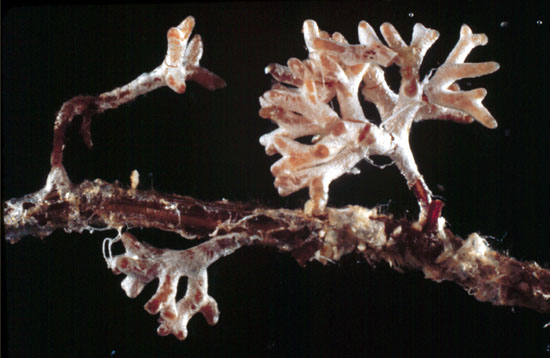
Ectomycorrhizae: Ectomycorrhizae form sheaths, called a mantle, around the roots of plants, as shown in this image.
Through mycorrhization, the plant obtains phosphate and other minerals, such as zinc and copper, from the soil. The fungus obtains nutrients, such as sugars, from the plant root. Mycorrhizae help increase the surface area of the plant root system because hyphae, which are narrow, can spread beyond the nutrient depletion zone. Hyphae are long extensions of the fungus, which can grow into small soil pores that allow access to phosphorus otherwise unavailable to the plant. The beneficial effect on the plant is best observed in poor soils. The benefit to fungi is that they can obtain up to 20 percent of the total carbon accessed by plants. Mycorrhizae function as a physical barrier to pathogens. They also provides an induction of generalized host defense mechanisms, which sometimes involves the production of antibiotic compounds by the fungi. Fungi have also been found to have a protective role for plants rooted in soils with high metal concentrations, such as acidic and contaminated soils.
There are two types of mycorrhizae: ectomycorrhizae and endomycorrhizae. Ectomycorrhizae form an extensive dense sheath around the roots, called a mantle. Hyphae from the fungi extend from the mantle into the soil, which increases the surface area for water and mineral absorption. This type of mycorrhizae is found in forest trees, especially conifers, birches, and oaks. Endomycorrhizae, also called arbuscular mycorrhizae, do not form a dense sheath over the root. Instead, the fungal mycelium is embedded within the root tissue. Endomycorrhizae are found in the roots of more than 80 percent of terrestrial plants.
Plant Pathogens
There are four main bacterial pathogenicity factors: cell wall degrading enzymes, toxins, phytohormones, and effector proteins.
Learning Objectives
Break down the types and modes of plant pathogenicity
Key Takeaways
Key Points
- The majority of phytopathogenic fungi belong to the Ascomycetes and the Basidiomycetes.
- Many soil inhabiting fungi are capable of living saprotrophically, carrying out the part of their lifecycle in the soil.
- Bacterial plant pathogens are much more prevalent in sub-tropical and tropical regions of the world.
Key Terms
- Type three secretion system: Type three secretion system (often written Type III secretion system and abbreviated TTSS or T3SS, also called Injectisome or Injectosome) is a protein appendage found in several Gram-negative bacteria. In pathogenic bacteria, the needle-like structure is used as a sensory probe to detect the presence of eukaryotic organisms and secrete proteins that help the bacteria infect them. The proteins are secreted directly from the bacterial cell into the eukaryotic cell, also known as "the host" cell.
Most bacteria that are associated with plants are actually saprophytic, and do no harm to the plant itself. However, a small number, around 100 species, are able to cause disease. Bacterial diseases are much more prevalent in sub-tropical and tropical regions of the world. Most plant pathogenic bacteria are rod shaped (bacilli). In order to be able to colonise the plant they have specific pathogenicity factors. There are 4 main bacterial pathogenicity factors:
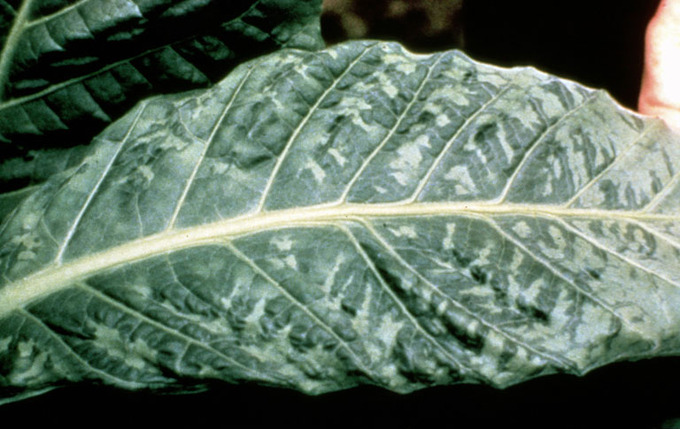
Tobacco Mosaic Disease: Photo of a tobacco leaf with symptoms of tobacco mosaic virus.
- Cell wall -degrading enzymes: These are used to break down the plant cell wall in order to release the nutrients inside.
- Toxins: These can be non- host -specific, which damage all plants, or host-specific, which cause damage only on a host plant.
- Phytohormones: example Agrobacterium changes the level of Auxin to cause tumours.
- Effector proteins: These can be secreted into the extracellular environment or directly into the host cell, often via the Type three secretion system. Some effectors are known to suppress host defense processes. This can include: reducing the plants internal signaling mechanisms or reduction of phytochemicals production. Bacteria, fungus and oomycetes are known for this function.
Significant bacterial plant pathogens:
- Burkholderia
- Proteobacteria
- Xanthomonas spp.
- Pseudomonas spp.
- Pseudomonas syringae pv. tomato causes tomato plants to produce less fruit, and it "continues to adapt to the tomato by minimizing its recognition by the tomato immune system. "
The majority of phytopathogenic fungi belong to the Ascomycetes and the Basidiomycetes. The fungi reproduce both sexually and asexually via the production of spores and other structures. Spores may be spread long distances by air or water, or they may be soil borne. Many soil inhabiting fungi are capable of living saprotrophically, carrying out the part of their lifecycle in the soil. These are known as facultative saprotrophs. Fungal diseases may be controlled through the use of fungicides and other agriculture practices, however new races of fungi often evolve that are resistant to various fungicides. · Biotrophic fungal pathogens colonize living plant tissue and obtain nutrients from living host cells. Necrotrophic fungal pathogens infect and kill host tissue and extract nutrients from the dead host cells.
Significant fungal plant pathogens include:
- Fusarium spp. (causal agents of Fusarium wilt disease)
- Thielaviopsis spp. (causal agents of: canker rot, black root rot, Thielaviopsis root rot)
- Verticillium spp.
- Magnaporthe grisea (causal agent of blast of rice and gray leaf spot in turfgrasses)
Nitrogen Fixation: Root and Bacteria Interactions
Plants cannot extract the necessary nitrogen from soil, so they form symbiotic relationships with rhizobia that can fix it as ammonia.
Learning Objectives
Explain the process and importance of nitrogen fixation
Key Takeaways
Key Points
- Diatomic nitrogen is abundant in the atmosphere and soil, but plants are unable to use it because they do not have the necessary enzyme, nitrogenase, to convert it into a form that they can use to make proteins.
- Soil bacteria, or rhizobia, are able to perform biological nitrogen fixation in which atmospheric nitrogen gas (N2) is converted into the ammonia (NH3) that plants are able to use to synthesize proteins.
- Both the plants and the bacteria benefit from the process of nitrogen fixation; the plant obtains the nitrogen it needs to synthesize proteins, while the bacteria obtain carbon from the plant and a secure environment to inhabit within the plant roots.
Key Terms
- rhizobia: any of various bacteria, of the genus Rhizobium, that form nodules on the roots of legumes and fix nitrogen
- nitrogen fixation: the conversion of atmospheric nitrogen into ammonia and organic derivatives, by natural means, especially by microorganisms in the soil, into a form that can be assimilated by plants
- nodule: structures that occur on the roots of plants that associate with symbiotic nitrogen-fixing bacteria
Nitrogen Fixation: Root and Bacteria Interactions
Nitrogen is an important macronutrient because it is part of nucleic acids and proteins. Atmospheric nitrogen, which is the diatomic molecule N2, or dinitrogen, is the largest pool of nitrogen in terrestrial ecosystems. However, plants cannot take advantage of this nitrogen because they do not have the necessary enzymes to convert it into biologically useful forms. However, nitrogen can be "fixed." It can be converted to ammonia (NH3) through biological, physical, or chemical processes. Biological nitrogen fixation (BNF), the conversion of atmospheric nitrogen (N2) into ammonia (NH3), is exclusively carried out by prokaryotes, such as soil bacteria or cyanobacteria. Biological processes contribute 65 percent of the nitrogen used in agriculture.
The most important source of BNF is the symbiotic interaction between soil bacteria and legume plants, including many crops important to humans. The NH3 resulting from fixation can be transported into plant tissue and incorporated into amino acids, which are then made into plant proteins. Some legume seeds, such as soybeans and peanuts, contain high levels of protein and are among the most important agricultural sources of protein in the world.

Diagram of the Nitrogen Cycle: Schematic representation of the nitrogen cycle. Abiotic nitrogen fixation has been omitted.

Nitrogen fixation in crops: Some common edible legumes, such as (a) peanuts, (b) beans, and (c) chickpeas, are able to interact symbiotically with soil bacteria that fix nitrogen.
Soil bacteria, collectively called rhizobia, symbiotically interact with legume roots to form specialized structures called nodules in which nitrogen fixation takes place. This process entails the reduction of atmospheric nitrogen to ammonia by means of the enzyme nitrogenase. Therefore, using rhizobia is a natural and environmentally-friendly way to fertilize plants as opposed to chemical fertilization that uses a non-renewable resource, such as natural gas. Through symbiotic nitrogen fixation, the plant benefits from using an endless source of nitrogen from the atmosphere. The process simultaneously contributes to soil fertility because the plant root system leaves behind some of the biologically-available nitrogen. As in any symbiosis, both organisms benefit from the interaction: the plant obtains ammonia and bacteria obtain carbon compounds generated through photosynthesis, as well as a protected niche in which to grow.
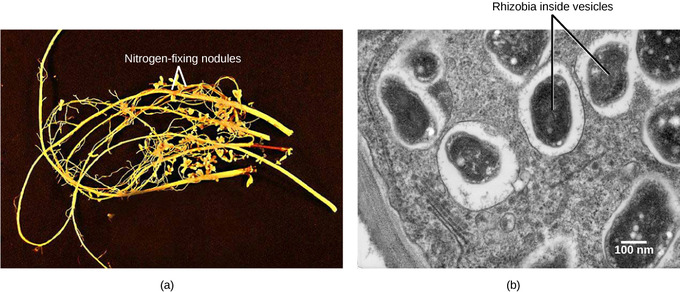
Rhizobia: Soybean roots contain (a) nitrogen-fixing nodules. Cells within the nodules are infected with Bradyrhyzobium japonicum, a rhizobia or "root-loving" bacterium. The bacteria are encased in (b) vesicles inside the cell, as can be seen in this transmission electron micrograph.
Licenses and Attributions
CC licensed content, Shared previously
- Curation and Revision. Provided by: Boundless.com. License: CC BY-SA: Attribution-ShareAlike
CC licensed content, Specific attribution
- OpenStax College, Biology. October 17, 2013. Provided by: OpenStax CNX. Located at: https://openstax.org/books/biology/pages/31-2-the-soil. License: CC BY: Attribution
- OpenStax College, Biology. November 21, 2013. Provided by: OpenStax CNX. License: CC BY: Attribution
- humus. Provided by: Wiktionary. Located at: https://en.wiktionary.org/wiki/humus. License: CC BY-SA: Attribution-ShareAlike
- loam. Provided by: Wiktionary. License: CC BY-SA: Attribution-ShareAlike
- OpenStax College, The Soil. October 17, 2013. Provided by: OpenStax CNX. Located at: https://cnx.org/resources/94af46e2ee398a72f66ae10dbe69df2f1ecb1f63/Figure_31_02_01.png. License: CC BY: Attribution
- OpenStax College, Biology. October 17, 2013. Provided by: OpenStax CNX. Located at: https://openstax.org/books/biology/pages/31-2-the-soil. License: CC BY: Attribution
- topsoil. Provided by: Wiktionary. License: CC BY-SA: Attribution-ShareAlike
- subsoil. Provided by: Wiktionary. License: CC BY-SA: Attribution-ShareAlike
- OpenStax College, The Soil. October 17, 2013. Provided by: OpenStax CNX. Located at: https://cnx.org/resources/94af46e2ee398a72f66ae10dbe69df2f1ecb1f63/Figure_31_02_01.png. License: CC BY: Attribution
- OpenStax College, The Soil. October 17, 2013. Provided by: OpenStax CNX. Located at: https://cnx.org/resources/0755a70bb4c7fe54ad67a1cba5b452a3dc1f4130/Figure_31_02_02.png. License: CC BY: Attribution
- OpenStax College, The Soil. October 17, 2013. Provided by: OpenStax CNX. Located at: https://cnx.org/resources/710488c7a8a03db9a79b47a0d612605ec19a80ab/Figure_31_02_03.jpg. License: CC BY: Attribution
- Mycorrhiza. Provided by: Wikipedia. License: CC BY-SA: Attribution-ShareAlike
- mycorrhiza. Provided by: Wikipedia. License: CC BY-SA: Attribution-ShareAlike
- OpenStax College, The Soil. October 17, 2013. Provided by: OpenStax CNX. Located at: https://cnx.org/resources/94af46e2ee398a72f66ae10dbe69df2f1ecb1f63/Figure_31_02_01.png. License: CC BY: Attribution
- OpenStax College, The Soil. October 17, 2013. Provided by: OpenStax CNX. Located at: https://cnx.org/resources/0755a70bb4c7fe54ad67a1cba5b452a3dc1f4130/Figure_31_02_02.png. License: CC BY: Attribution
- OpenStax College, The Soil. October 17, 2013. Provided by: OpenStax CNX. Located at: https://cnx.org/resources/710488c7a8a03db9a79b47a0d612605ec19a80ab/Figure_31_02_03.jpg. License: CC BY: Attribution
- Mycorrhizal root tips (amanita). Provided by: Wikipedia. Located at: https://en.wikipedia.org/wiki/File:Mycorrhizal_root_tips_(amanita).jpg. License: CC BY: Attribution
- Environmental soil science. Provided by: Wikipedia. License: CC BY-SA: Attribution-ShareAlike
- Wetland. Provided by: Wikipedia. License: CC BY-SA: Attribution-ShareAlike
- Soil respiration. Provided by: Wikipedia. License: CC BY-SA: Attribution-ShareAlike
- Bacteria. Provided by: Wikipedia. License: CC BY-SA: Attribution-ShareAlike
- Soil life. Provided by: Wikipedia. License: CC BY-SA: Attribution-ShareAlike
- Pedosphere. Provided by: Wikipedia. License: CC BY-SA: Attribution-ShareAlike
- methanogenesis. Provided by: Wiktionary. License: CC BY-SA: Attribution-ShareAlike
- heterotroph. Provided by: Wiktionary. License: CC BY-SA: Attribution-ShareAlike
- denitrification. Provided by: Wiktionary. License: CC BY-SA: Attribution-ShareAlike
- OpenStax College, The Soil. October 17, 2013. Provided by: OpenStax CNX. Located at: https://cnx.org/resources/94af46e2ee398a72f66ae10dbe69df2f1ecb1f63/Figure_31_02_01.png. License: CC BY: Attribution
- OpenStax College, The Soil. October 17, 2013. Provided by: OpenStax CNX. Located at: https://cnx.org/resources/0755a70bb4c7fe54ad67a1cba5b452a3dc1f4130/Figure_31_02_02.png. License: CC BY: Attribution
- OpenStax College, The Soil. October 17, 2013. Provided by: OpenStax CNX. Located at: https://cnx.org/resources/710488c7a8a03db9a79b47a0d612605ec19a80ab/Figure_31_02_03.jpg. License: CC BY: Attribution
- Mycorrhizal root tips (amanita). Provided by: Wikipedia. Located at: https://en.wikipedia.org/wiki/File:Mycorrhizal_root_tips_(amanita).jpg. License: CC BY: Attribution
- FoodWeb. Provided by: Wikipedia. License: Public Domain: No Known Copyright
- Nad redox. Provided by: Wikimedia. License: Public Domain: No Known Copyright
- Endophyte. Provided by: Wikipedia. License: CC BY-SA: Attribution-ShareAlike
- endophyte. Provided by: Wiktionary. License: CC BY-SA: Attribution-ShareAlike
- OpenStax College, The Soil. October 17, 2013. Provided by: OpenStax CNX. Located at: https://cnx.org/resources/94af46e2ee398a72f66ae10dbe69df2f1ecb1f63/Figure_31_02_01.png. License: CC BY: Attribution
- OpenStax College, The Soil. October 17, 2013. Provided by: OpenStax CNX. Located at: https://cnx.org/resources/0755a70bb4c7fe54ad67a1cba5b452a3dc1f4130/Figure_31_02_02.png. License: CC BY: Attribution
- OpenStax College, The Soil. October 17, 2013. Provided by: OpenStax CNX. Located at: https://cnx.org/resources/710488c7a8a03db9a79b47a0d612605ec19a80ab/Figure_31_02_03.jpg. License: CC BY: Attribution
- Mycorrhizal root tips (amanita). Provided by: Wikipedia. License: CC BY: Attribution
- FoodWeb. Provided by: Wikipedia. License: Public Domain: No Known Copyright
- Nad redox. Provided by: Wikimedia. License: Public Domain: No Known Copyright
- Soybean-root-nodules. Provided by: Wikipedia. License: Public Domain: No Known Copyright
- OpenStax College, Biology. October 17, 2013. Provided by: OpenStax CNX. Located at: https://openstax.org/books/biology/pages/31-3-nutritional-adaptations-of-plants. License: CC BY: Attribution
- Mycorrhiza. Provided by: Wikipedia. License: CC BY-SA: Attribution-ShareAlike
- mycorrhiza. Provided by: Wikipedia. License: CC BY-SA: Attribution-ShareAlike
- hypha. Provided by: Wikipedia. License: CC BY-SA: Attribution-ShareAlike
- mycelium. Provided by: Wiktionary. License: CC BY-SA: Attribution-ShareAlike
- OpenStax College, The Soil. October 17, 2013. Provided by: OpenStax CNX. Located at: https://cnx.org/resources/94af46e2ee398a72f66ae10dbe69df2f1ecb1f63/Figure_31_02_01.png. License: CC BY: Attribution
- OpenStax College, The Soil. October 17, 2013. Provided by: OpenStax CNX. Located at: https://cnx.org/resources/0755a70bb4c7fe54ad67a1cba5b452a3dc1f4130/Figure_31_02_02.png. License: CC BY: Attribution
- OpenStax College, The Soil. October 17, 2013. Provided by: OpenStax CNX. Located at: https://cnx.org/resources/710488c7a8a03db9a79b47a0d612605ec19a80ab/Figure_31_02_03.jpg. License: CC BY: Attribution
- Mycorrhizal root tips (amanita). Provided by: Wikipedia. License: CC BY: Attribution
- FoodWeb. Provided by: Wikipedia. License: Public Domain: No Known Copyright
- Nad redox. Provided by: Wikimedia. License: Public Domain: No Known Copyright
- Soybean-root-nodules. Provided by: Wikipedia. License: Public Domain: No Known Copyright
- Ectomycorrhizae 001. Provided by: Wikimedia. License: CC BY-SA: Attribution-ShareAlike
- OpenStax College, Nutritional Adaptations of Plants. October 17, 2013. Provided by: OpenStax CNX. Located at: https://cnx.org/resources/67b791bce5753214d31f97f74c41c50ee2aaa677/Figure_31_03_03.jpg. License: CC BY: Attribution
- Type three secretion system. Provided by: Wikipedia. License: CC BY-SA: Attribution-ShareAlike
- Microbial inoculant. Provided by: Wikipedia. License: CC BY-SA: Attribution-ShareAlike
- Plant pathogens. Provided by: Wikipedia. License: CC BY-SA: Attribution-ShareAlike
- Horticulture/Phytopathology. Provided by: Wikibooks. License: CC BY-SA: Attribution-ShareAlike
- OpenStax College, The Soil. October 17, 2013. Provided by: OpenStax CNX. Located at: https://cnx.org/resources/94af46e2ee398a72f66ae10dbe69df2f1ecb1f63/Figure_31_02_01.png. License: CC BY: Attribution
- OpenStax College, The Soil. October 17, 2013. Provided by: OpenStax CNX. Located at: https://cnx.org/resources/0755a70bb4c7fe54ad67a1cba5b452a3dc1f4130/Figure_31_02_02.png. License: CC BY: Attribution
- OpenStax College, The Soil. October 17, 2013. Provided by: OpenStax CNX. Located at: https://cnx.org/resources/710488c7a8a03db9a79b47a0d612605ec19a80ab/Figure_31_02_03.jpg. License: CC BY: Attribution
- Mycorrhizal root tips (amanita). Provided by: Wikipedia. License: CC BY: Attribution
- FoodWeb. Provided by: Wikipedia. License: Public Domain: No Known Copyright
- Nad redox. Provided by: Wikimedia. License: Public Domain: No Known Copyright
- Soybean-root-nodules. Provided by: Wikipedia. License: Public Domain: No Known Copyright
- Ectomycorrhizae 001. Provided by: Wikimedia. License: CC BY-SA: Attribution-ShareAlike
- OpenStax College, Nutritional Adaptations of Plants. October 17, 2013. Provided by: OpenStax CNX. Located at: https://cnx.org/resources/67b791bce5753214d31f97f74c41c50ee2aaa677/Figure_31_03_03.jpg. License: CC BY: Attribution
- Provided by: Wikimedia. Located at: https://upload.wikimedia.org/wikipedia/commons/2/26/Tobacco_mosaic_virus_symptoms_tobacco.jpg. License: Public Domain: No Known Copyright
- OpenStax College, Biology. October 17, 2013. Provided by: OpenStax CNX. Located at: https://openstax.org/books/biology/pages/31-3-nutritional-adaptations-of-plants. License: CC BY: Attribution
- nodule. Provided by: Wikipedia. License: CC BY-SA: Attribution-ShareAlike
- rhizobia. Provided by: Wiktionary. License: CC BY-SA: Attribution-ShareAlike
- nitrogen fixation. Provided by: Wiktionary. License: CC BY-SA: Attribution-ShareAlike
- OpenStax College, The Soil. October 17, 2013. Provided by: OpenStax CNX. Located at: https://cnx.org/resources/94af46e2ee398a72f66ae10dbe69df2f1ecb1f63/Figure_31_02_01.png. License: CC BY: Attribution
- OpenStax College, The Soil. October 17, 2013. Provided by: OpenStax CNX. Located at: https://cnx.org/resources/0755a70bb4c7fe54ad67a1cba5b452a3dc1f4130/Figure_31_02_02.png. License: CC BY: Attribution
- OpenStax College, The Soil. October 17, 2013. Provided by: OpenStax CNX. Located at: https://cnx.org/resources/710488c7a8a03db9a79b47a0d612605ec19a80ab/Figure_31_02_03.jpg. License: CC BY: Attribution
- Mycorrhizal root tips (amanita). Provided by: Wikipedia. License: CC BY: Attribution
- FoodWeb. Provided by: Wikipedia. License: Public Domain: No Known Copyright
- Nad redox. Provided by: Wikimedia. License: Public Domain: No Known Copyright
- Soybean-root-nodules. Provided by: Wikipedia. License: Public Domain: No Known Copyright
- Ectomycorrhizae 001. Provided by: Wikimedia. License: CC BY-SA: Attribution-ShareAlike
- OpenStax College, Nutritional Adaptations of Plants. October 17, 2013. Provided by: OpenStax CNX. Located at: https://cnx.org/resources/67b791bce5753214d31f97f74c41c50ee2aaa677/Figure_31_03_03.jpg. License: CC BY: Attribution
- Provided by: Wikimedia. Located at: https://upload.wikimedia.org/wikipedia/commons/2/26/Tobacco_mosaic_virus_symptoms_tobacco.jpg. License: Public Domain: No Known Copyright
- Nitrogen Cycle. Provided by: Wikipedia. License: CC BY-SA: Attribution-ShareAlike
- OpenStax College, Nutritional Adaptations of Plants. October 17, 2013. Provided by: OpenStax CNX. Located at: https://cnx.org/resources/0ff25a4e21212e351394afe8cedc9682aaff736d/Figure_31_03_01abc.png. License: CC BY: Attribution
- OpenStax College, Nutritional Adaptations of Plants. October 17, 2013. Provided by: OpenStax CNX. Located at: https://cnx.org/resources/c45d92bd391c88b5a69236abeffa14f9994263af/Figure_31_03_02ab.jpg. License: CC BY: Attribution
Source: https://www.coursehero.com/study-guides/boundless-microbiology/soil-and-plant-microbiology/